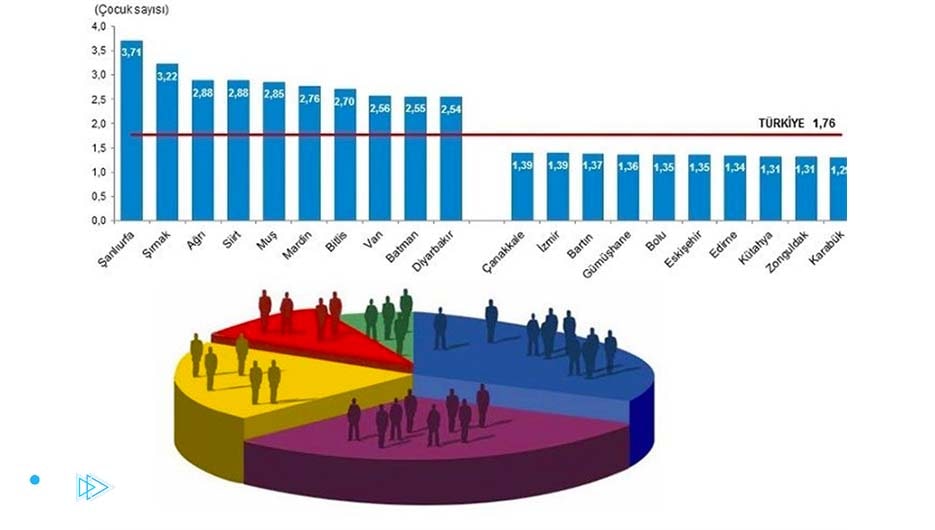
The latest UN census statistics show that Turkey is the 19th most populous country in the world.
According to the United Nations, Turkey ranks 19th with 83,384,680 people.
While Germany came in 18th place with 83 million and 783 thousand and 954 people.
-Advertisement-
Statistics show that the pace of population growth in Turkey has slowed down and that factors such as the rising age of marriage and consequently the increasing age of childbearing. Along with some demographic differences in different provinces and regions in Turkey, contain information that worries the Turkish government.
The latest official data issued by the Turkish National Statistical Center shows that the economic situation in the past few years and the emergence of major problems such as unprecedented inflation and unemployment, negatively affected population growth and a large percentage of young Turks do not marry.
As a member of NATO, Turkey has the most populous of the members of this military alliance’s armed forces.
It is also natural that the pace of population growth, in addition to its importance in the economic and agricultural fields, is of great importance in the field of defense.
-Advertisement-
Concern about the ethnic and regional dimensions of population growth
One important demographic parameter is the fertility rate.
The figure given as TFR actually refers to the average number of births for a woman in the ideal birth age range, i.e. between the ages of 15 and 49.
The total fertility rate was 2.38 in 2001 and 1.76 in 2020.
In 2019, the number of live births in Turkey was 1,186,560.
But in 2020, it reached 1,112,859 children.
Among the 81 provinces in Turkey, the top ten ranks are the Kurdish provinces.
In terms of the province’s index, the Kurdish province of Şanlıurfa had the highest fertility rate of 3.71 children in 2020.
And the second province is the Kurdish province of Şırnakh, with a rate of 3.22 children.
And the other two Kurdish provinces, Sirat and Agri, ranked third and fourth.
The provinces from the fifth to the tenth of the list are among the other six Kurdish provinces, which are: Muş, Mardin, Batlis, Van, Batman and Diyarbakir.
The average fertility rate is high in the Kurdish provinces, while the Turkish provinces are in a different situation.
The fertility rate was 1.29 in Karabuk and 1.31 in Zonguldak and Kütahya.

The above graph shows that the average fertility rate in Turkey is 1.76, but in 10 Kurdish provinces it is twice the national average.
In the past few years, we have seen an increasing strengthening of the Turkish nationalist discourse in Turkey due to the formation of the Republican Alliance, the alliance of the Justice and Development Party and the Conservative Democratic Development Party, with Turkey’s right wing, the National Movement Party.
As a result, the Erdogan-Bahçeli alliance cannot ignore the statistical fact that the population growth rate in the Kurdish provinces is much higher than in the Turkish provinces.
-Advertisement-
Increasing the average lifespan of a woman in her first marriage
The average age of first marriage for a woman, which was 24.4 years in 2015, was 25.1 years in 2020.
According to marriage records, the official marriage rate for girls in the 16-17 age group was 7.8% of all official marriages in 2010, but fell to 2.7% in 2020.
Of course, civil society organizations and groups active in preventing child and adolescent marriage are satisfied with this situation.
It is also important to note that, in general, the average age of marriage for girls and boys among conservative families is lower than in Kemalist, liberal, and pro-Western families.
-Advertisement-
High rise, unemployment and immigration
Critics and opponents of Erdogan’s government believe that the National Statistical Office does not provide clear information on unemployment for fear of the presidency.
The evidence for this allegation is the dismissal of the two Vice-Presidents of the National Center for Statistics, who, in the eyes of the government, published ambiguous information.
Therefore, there were many accounts about the announcement of clear and accurate statistics on unemployment in Turkey.
Knowing the true dimensions of unemployment statistics is directly related to the motives for marriage and demographic change.
Thus the importance of this factor cannot be ignored.

But in any case, the real and clear picture of political, economic and social developments in Turkey is that the wave of migration of young people from Turkey to European countries has intensified and one of the main reasons is the lack of hope for job opportunities and employment.
As a result, a large part of Turkey’s young elite, especially those who graduated from major Turkish high schools, go to Europe for university studies, while graduates of the best Turkish universities often look for a way to stay in other countries.
Finally, in Turkey, as in other countries of the world, there is a direct relationship between livelihoods, the economic situation and the social and political conditions of the country.
In recent years, the Turkish economy has been plagued by a major crisis that must be eliminated if the current demographic challenges are to be faced.






















